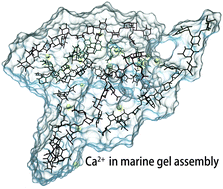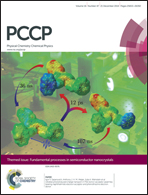Molecular dynamics simulations reveal the assembly mechanism of polysaccharides in marine aerosols†
Abstract
The high Arctic marine environment has recently detected polymer gels in atmospheric aerosol particles and cloud water originating from the surface microlayer of the open leads within the pack ice area. These polysaccharide molecules are water insoluble but water solvated, highly surface-active and highly hydrated (99% water). In order to add to the understanding and to complement missing laboratory characterization of marine polymer gels we have in this work performed an atomistic study of the assembly process and interfacial properties of polysaccharides. Our study reveals a number of salient features of the microscopic process behind polysaccharide assembly into nanogels. With three- and four-repeating units the polysaccharides assemble into a cluster in 50 ns. The aggregates grow quicker by absorbing one or two polymers each time, depending on the unit length and the type of inter-bridging cation. Although both the hydrophobic and hydrophilic domains are contracted, the latter dominates distinctly upon the contraction of solvent accessible surface areas. The establishment of inter-chain hydrogen-bonds is the key to the assembly while ionic bridges can further promote aggregation. During the assembly of the more bent four-unit polymers, intra-chain hydrogen bonds are significantly diminished by Ca2+. Meanwhile, the percentage of Ca2+ acting as an ionic bridge is more eminent, highlighting the significance of Ca2+ ions for longer-chain polysaccharides. The aggregates are able to enhance surface tension more in the presence of Ca2+ than in the presence of Na+ owing to their more compact structure. These conclusions all demonstrate that studies of the present kind provide insight into the self-assembly process and interfacial properties of marine gels. We hope this understanding will keep up the interest in the complex and the fascinating relationship between marine microbiology, atmospheric aerosols, clouds and climate.


 Please wait while we load your content...
Please wait while we load your content...